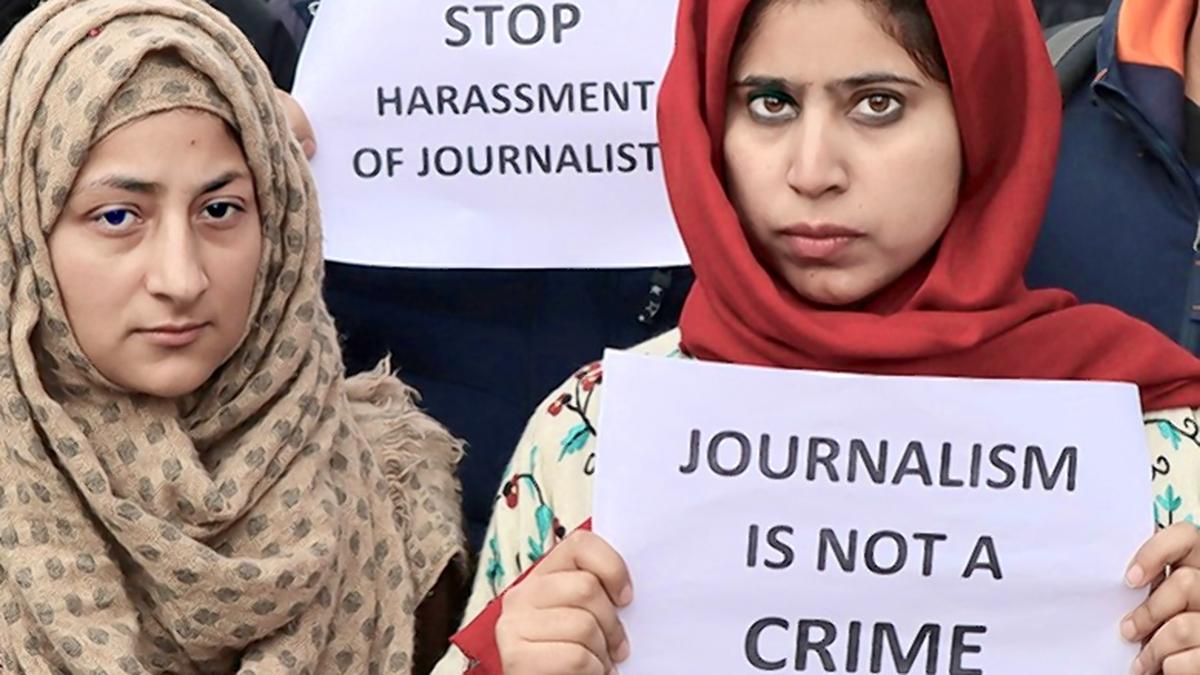Journalists hold placards during a protest in Srinagar on December 18, 2019.
| Photo Credit: The Hindu
Navigating powers in a conflict zone in search of truth is a daunting challenge for journalists. There is a cost to pay for digging for the truth, and bitter truths could prove costlier. The murder of 33-year-old freelance journalist and YouTuber, Mukesh Chandrakar, from Chhattisgarh is a grim reminder of the cost that people pay for holding a mirror to a corrupt system.
In the case of Kashmir, which has seen different phases of violent conflict, journalists could not operate without survival kits. Covering Kashmir in the 1990s, at the peak of militancy, required one set of survival kits to navigate warring parties’ intimidation and threats to control narratives. Post-2008, when Kashmir was in the throes of street violence, journalists fine-tuned their operations to ensure reporting truth was not compromised.
However, post-2019, when Jammu and Kashmir’s status was downgraded to a Union Territory and special status ended, control and fear became the new instruments for dealing with journalists. There were no survival kits in a dynamic situation where red lines, drawn by State institutions, would change with each passing day for reporters. A ban was put on reporting live encounters, and permission was denied to get closer to the area where militants and security forces would engage in a firefight, unlike in the past. Official versions became the main narratives. Anyone expressing views contrary to the official position was not invited to official functions and was barred from attending visits of official dignitaries.
In September 2019, I filed a report on police data on detentions, especially of mainstream leaders and protesters. The story surfaced when officials denied having centralised data on detentions in Kashmir. A police summon followed the publication of the report and I was asked to reveal my source. However, it was not the summon that was intimidating. The actions taken against my sources in the administration were chilling. Any office where I signed the check-in logbook was scanned to identify my sources, who were then placed under surveillance and received cryptic warnings. Access to my sources was cut off to the extent that most stopped responding or meeting me.
For many colleagues, it was worse. There was a joke doing the rounds in Kashmir among media persons: post-2019, there were two types of journalists — those who had been raided by security agencies and those who were yet to be raided. Even now, the laptops, drives, and mobile phones of many journalists are with security agencies. Summons and raids were another chilling reminder that the search for truth had become a daring act. Two freelance journalists, Majid Hyderi and Irfan Mehraj, still remain behind bars. While Hyderi faces charges under the Public Safety Act, Mehraj is charged under the provisions of the Unlawful Activities (Prevention) Act.
Long way ahead
On January 3, 2025, J&K Chief Minister Omar Abdullah’s maiden and free-wheeling interaction with the press in Srinagar was held against this backdrop. In fact, Mr. Abdullah’s opening remarks were itself a commentary on the functioning of the press. As he took many inconvenient questions, he sparked hope that there are freer times ahead. “My wish would be to see a free and open media. This interaction is a step in that direction, where you are not given a list of what you can or cannot ask,” he said.
However, there is a long way to go. The Kashmir Press Club has remained shut for many years. Dozens of local scribes have already left Kashmir, and many independent journalists have changed their trade in the face of tough times. The clampdown created a vacuum, which was filled by non-professionals who let sensationalism rather than sensibility dictate the terms of engagement.
Published – January 10, 2025 01:41 am IST

